#but i think that's a mechanical limitation and i find this more interesting
Text
Playing around with an old idea of mine. In this, the Knight challenges Leif to battle in Godhome, who accepts. Thought it'd be neat if the Knight dream nailed Leif to see what he thinks.
So. You know.
"these webs... can't… move… can't… think… so… hungry… she's safe now… all that matters…"
"It just pretended to hit us. Does it do that often? Whatever. This challenge.. we haven't dueled one on one before... outside of cards, at least. This should be interesting. The magic it radiates is so different from anything we know. It is such a strange little thing."
#bug fables#hollow knight#bug fables spoilers#bf leif#the dream nail reads the last thoughts of a dead creature and the current thoughts of a living creature#since Leif is both dead moth and living cordyceps#you get both for the price of one#which isn't actually how it works in hollow knight as seen with the corpse creepers#but i think that's a mechanical limitation and i find this more interesting
33 notes
·
View notes
Note
from a non-academic, i find parts of comphet to be useful (heterosexuality becomes compulsory when you’re raised in a heterosexual society) but the foundations . suck. what do we do with theories like this, that have touched on a truth but also carry a lot of garbage? can we separate the truth from the founder?
i have to be slightly pedantic and say that i don't think rich's essay is an example of this phenomenon. my central issue with her formulation is its bioessentialist assumptions about human sex and therefore also sexuality. if i say "capitalism includes economic mechanisms that enforce heterosexual behaviour and exclude other possibilities", then what i mean by "heterosexual" is plainly not the same as what rich means—and for this reason i would seldom formulate the statement this way, without clarifying that i am talking about the enforcement of heterosexuality as a part of the creation and defence of sex/gender categories themselves. so rich and i do not actually agree on the very fundamental premises of this paper! rich was not the first or only person to point out that economic mechanisms as well as resultant social norms enforce heterosexual pairings; i actually don't even think the essay does a very clear job of interrogating the relationship between labour, economy, and the creation of sex/gender; she means something different and essentialist to what i mean by sex and sexuality; and i think her proposed responses to the phenomenon she identifies as 'compulsory heterosexuality' are uninteresting because they mainly propose psychological answers to a problem arising from conditions of political economy. so, in regards to this specific paper, i am actually totally comfortable just saying that it's not a useful formulation, and i don't feel a need to rescue elements of it.
in general, i do know what you're talking about, and i think there's a false dichotomy here: as though we must either discard an idea entirely if it has elements we dislike, or we accept it on the condition that we can plausibly claim these elements and their author are irrelevant. these are not comprehensive options. instead, i would posit that every theory, hypothesis, or idea is laden with context, including values held and assumptions made by their progenitors. the point is not to find a mythical 'objective' truth unburdened by human bias or mistakes; this is impossible. instead, i think we need to take seriously the elements of an idea that we object to. why are they there? what sorts of assumptions or arguments motivate them, and are those actually separable from whatever we like in the idea? if so, can we be clear about which aspects of the theory are still useful or applicable, and where it is that the objectionable elements arise? and if we can identify these points, then what might we propose instead? this is all much more useful, imo, than either waiting for a perfect morally unimpeachable theory or trying to 'accept' a theory without grappling with its origins (political, social, intellectual).
a recent example that you might find interesting as a kind of case study is j lorand matory's book the fetish revisited, which argues that the 'fetish' concept in freud's and marx's work drew from their respective understandings of afro-atlantic gods. in other words, when marx said capitalists "fetishise" commodities or freud spoke about sexual "fetishism", they were each claiming that viewing an object as agentive, meaning-laden in itself (ie, devoid of the context of human meaning-making as a social and political activity) was comparable to 'primitive' and delusory religious practices.
matory's point here isn't that we should reject marx's entire contribution to political economy because he was racist, nor is it that we can somehow accept parts of what marx said by just excising any racist bits. rather, matory asks us to grapple seriously with the role that marx's anthropologically inflected racism plays in his ideas, and what limitations it imposes on them. why is it that marx could identify the commodity as being discursively abstracted and 'fetishised', but did not apply this understanding to other ideas and objects in a consistent way? and how is his understanding of this process of 'fetishisation' shaped by his beliefs about afro-atlantic peoples, and their 'intelligence' or civilisational achievements in comparison to northwestern europeans'? by this critique matory is able to nuance the fetish concept, and to argue that marx's formulation of it was both reductive and inconsistently applied (analogously to how freud viewed only some sexuality as 'fetishistic'). it is true in some sense that capital and the commodity are reified and abstracted in a manner comparable to the creation of a metaphysical entity, but what we get from matory is both a better, more nuanced understanding of this process of meaning-making (incl. a challenge to the racist idea of afro-atlantic gods as simply a result of inferior intelligence or cultural development), and the critical point that if this is fetishism, then we must understand a lot more human discourse and activity as hinging on fetishisation.
the answer of what we do with the shitty or poorly formulated parts of a theory won't always be the same, obviously; this is a dialogue we probably need to have (and then have again) every time we evaluate an idea or theory. but i hope this gives you some jumping-off points to consider, and an idea of what it might look like to grapple with ideas as things inherently shaped by people—and our biases and assumptions and failings—without assuming that means we can or should just discard them any time those failings show through. the point is not to waste time trying to find something objective, but to understand the subjective in its context and with its strengths and limitations, and then to decide from there what use we can or should make of it.
541 notes
·
View notes
Text
Introduction to the OSR
what's an OSR? it's a game that's kinda like old-school D&D. or is old-school D&D. or is compatible with old-school D&D. an OSR game generally has some or all of the following principles:
low character power with highly lethal combat. in old-school D&D a 1st-level fighter has d8 hit points and a longsword does d8 damage, and you die at 0HP. this is not to ensure characters die all the time but to emphasize the next bullet point:
emphasis on creative problem solving. most situations cannot be solved by straightforward use of your abilities (such as charging into every situation with swords drawn, if a fighter), so the game tests lateral, outside-the-box thinking.
emphasis on diegetic progression. spells are found, not obtained automatically on level-up. you get XP by finding gold more than killing monsters. most of your cool abilities come from magic items. making alliances & hiring followers is encouraged.
focus on managing inventory, resources, risk, and time. the players are constantly faced with meaningful decisions; this is the heart of the game.
very sandbox-oriented. the focus on creative problem solving means the game must be accommodating to players taking a course of action the GM didn't plan for. use lots of random tables to generate emergent story. some elements of new simulationism.
high tactical transparency, i.e., the optimal course of action is rarely system-specific, and ideally very possible for a new player to intuit.
usually semi-compatible with old D&D, but not always. usually rules-lite, but not always.
what does the OSR mostly NOT do?
focus on character builds. these change the focus too much to be on the rules than the fiction, can create situations where stuff everyone should be able to do is an ability locked to one class, and impede tactical transparency.
resolve everything with a die roll. combat uses dice to be scary, unpredictable and most importantly not your default course of action. everything else should bring up dice rarely - dice are your plan B when your plan A fails. the best plans need no dice.
use linear storytelling or put players into a writer/GM role. linear storytelling gets in the way of the decision-making so core to the playstyle; letting players write details into the setting is mutually exclusive with them discovering it.
rules for everything. 400 pages of crunch is worse at simulating a believable world than the GM and players' shared understanding. OSR games rely constantly on GM ruling.
mostly still applies to all the above. making your system a "pure" OSR game comes second to doing what's best for your game.
System recommendations
old D&D or a retroclone
old-school D&D - or old school essentials or basic fantasy or swords & wizardry, which are old D&D's mechanics repackaged with quality-of-life tweaks (and the upside of not giving WOTC your money) - are usually the go-to when recommending someone's first OSR game. they're actually not my first pick, though!
PROS:
very complete, with more robust rules than a lot of the lighter games on this list.
100% compatibility: most OSR adventures are statted for old school essentials. converting them to other OSR systems is usually simple, but not 1-for-1.
easier to find games for. anyone interested in the OSR space knows what old school essentials is.
CONS:
jank. these games largely still have weird saves, level limits for non-humans, some still have descending AC, etc etc. it's not that bad but it is there
i hate thief skills. lots of essential dungeoneering actions are locked to the thief class as abilities, with abysmally low success chances. this is stuff i prefer being handled without a roll. thieves in this system suck and make everyone else worse at dungeon crawling by existing.
there's just lots of really cool shit in other systems i'm about to go into that you just don't get here
Knave 1e and its various hacks
this is a 7-page super-lightweight system that boils everything down to just the essentials.
rolling a character takes like 5 minutes. roll stats, roll gear, roll traits, go. done. it's great.
characters are defined entirely by stats and gear, no classes. wanna be a fighter, have high strength and carry a big sword and armor. wanna be a wizard, have high intelligence and fill your inventory with spells. item slots are elegant and pretty limited.
initiative is instant: roll d6. 1-3, monsters go first. 4-6, PCs go first. swingy, but god it is so smooth and shaves like the most boring 5 minutes off of every combat
monsters are so very elegant. old D&D gives monsters a "hit dice" rating to determine their HP, e.g. a 3HD monster rolls 3d8 for hit points. knave takes this number (HD) and uses it for attack rolls and saves (aside from exceptionally bad/good saves), so a knave statblock looks something like this.
spells are all one or two sentences long & extremely easy to remember.
7 pages is so light. i have the system basically memorized.
DOWNSIDES: there's no dungeon crawling rules (standard for meatier OSR games & something i consider essential) and no real bestiary, though the second point isn't a huge deal cause they're so easy to make. it also kinda assumes you already know how to run OSR games, so there's very little real advice or guidance.
KNAVE HACKS
knave 1e is in creative commons & comes with an editable word doc for you to publish with modifications, so there's a ton of variants (there was a spreadsheet of them somewhere, but i can't find it).
Grave is a favorite - i'm two years into a grave campaign and it's fantastic. it's a dark-souls-y version of knave with some really elegant innovations.
you have a set number of deaths before you for-reals die, as every character plays an undead as is dark souls tradition. makes it good for OSR beginners! being able to tell when you're close to your final death is really good - it lets you emotionally prepare for losing your character & raises the stakes more the more you die. (though honestly you should probably cut the number of extra deaths in half, it's super generous)
XP and gold are combined into one resource, souls. legendary creatures drop big souls you can make into magic items. this has ended up being the coolest thing in my current campaign. my players love finding powerful souls to make into magic items it's so fun
uses preset packages of stats/gear instead of knave's rolled ones, filling the role of more traditional character classes. has the wonderful side effect of not making you get stuck with low stats cause you rolled bad one time.
you have stamina equal to your empty item slots. you spend stamina on spells if you're a caster, or free maneuvers (on top of your attack at no action cost) if you're not. it's super elegant.
there's 3 classes of spells: wizardry for intelligence, holy magic for wisdom, and witch stuff for charisma. nice and intuitive.
there's a page of 50 magic items each a couple sentences long. this PDF is worth it just for the magic items.
DOWNSIDE: see the downsides for knave 1e. all still apply.
i enjoyed grave so much i made a variant of it with the dark souls bits removed (and some dungeon crawl rules added!) to use for my standard fantasy campaigns.
Knave 2e
sadly knave 2e is not purchasable yet (i backed it on kickstarter so i have access, though). but when it comes out i highly recommend it.
much larger and denser than knave 1e. it finally has dungeon crawling rules, it has GM and player guidance, everything is refined and the layout is so so nice and readable.
combat is a bit more interesting than 1e. you can break your weapon against an enemy to deal max damage. you get a free maneuver on high attack rolls.
there's rules for stuff like alchemy, warfare, building a base. it all kicks ass.
there are so many goddamn tables. i rifle through it anytime i need inspiration.
DOWNSIDES: i personally can't think of any! it's a very complete good functional system.
Mausritter
you play tiny little mice! in a world full of big dangerous things that want to eat mice. cat = dragon. you get it. what more could you want
the mouse thing is just super intuitive. you get the dynamic between you and the big scary lethal world. fantastic OSR game to introduce kids
nice and robust ruleset; nothing feels missing
tons of super nice GM stuff! faction rules, tools for rolling up hexcrawls and dungeons, plenty of tables
super clean readable layout. font isn't too small to avoid being intimidating. guidance is really nice and clear.
combat is autohit. super fast & lethal.
100% free
look mausritter is just. good. i wanna run it so bad someday
Worlds Without Number
sort of a middle ground between OSR stuff and 5e.
lots of classes, at least in the paid version. the free version comes with just the warrior, expert and mage. there's feats and more of a focus on builds than most OSR games. if you like more mechanical build variety than a typical OSR game, this is a great game for you!
extremely good multiclassing. y'know how in most games if you just mash together two classes you think are cool you'll end up with a total mess? not here! every combo is viable and works fine! easily the best multiclassing of any game i've touched
an absurd amount of GM stuff and tables. easily more than any of the other stuff i've praised for also having them. but personally i haven't dug into them as much, so i can't really comment on them
skills the way modern D&D has them. you roll dice and try to beat a target number. i don't tend to like rolled skills, but most people do, so if that's your thing WWN has them
DOWNSIDES
the layout is terrible. everything is a huge wall of text with very little use of bold text or bullet points to draw attention to the important bits. the table of contents has like 15 things in it for a 400-page book! i couldn't find any of the paid-version-exclusive classes for like a month after i bought it! looking up rules is a nightmare.
the way the default setting handles "evil races" is like an exaggerated parody of all the problematic aspects of how D&D handles it. like, it wants so bad for you to have an excuse to genocide sentient free-willed people. but at least the default setting is easy to chuck in the trash
Dungeon Crawl Classics
the goal of this system is to take all of the crazy gonzo moments people remember playing old-school D&D in their childhood and turn all of that up to 11 while cutting the stuff that doesn't add to that. i think a lot of its innovations have ended up kind of standard in newer OSR stuff (like fighters getting maneuvers with their attacks), but it still has more to offer.
the funnel: you start the game with four randomly rolled dipshit peasants that you then throw into a meatgrinder to get horribly killed. you pick one of the survivors to be your 1st-level character.
maneuvers: fighters roll an extra die with each attack that gets bigger as you level. if it's a 3 or higher, you get to do a cool thing on top of your attack. pretty standard for OSR games, but this game popularized it!
crit tables: fighters also get more crits and nastier crits as they level. every crit, you roll on the crit table. maybe you chop off a dude's arm. maybe you just knock them over. maybe you shatter their shield. it's very cool
spell tables: i don't really like roll-to-cast mechanics, generally. but DCC goes so all-in on roll-to-cast that it still looks fun as hell to watch. you cast a fireball and maybe it goes how you want. or maybe you explode, or you nuke everything in a half-mile radius, or from now on you permanently ignite flammable materials you touch, or whatever. casters just have to put up with turning into a weird mutated mess across a campaign
there's no dungeon crawl rules, no encumbrance - this game is all about the big over-the-top wacky shit, and is not really interested in the more down-to-earth number crunching. it's more in the you-die-hilariously-all-the-time area of OSR than the you-avoid-death-through-clever-play area. not really my thing but the system knows exactly what it wants to be and i respect it
iron halberd
this one is mine! as the author i'm not qualified to tell you what isn't good about my system, so just assume it's worse than i make it sound, but here's a bunch of the selling points
semi-random character creation where you flip back and forth between rolling dice and getting your own input. roll stats, pick ancestry. pick starting gear kit, roll different dice based on which kit you picked. etc etc. stats are random but all equally viable (no rolling incredibly low or high stats). every time i run this game the character creation is a hit. seriously go roll up a character it'll sell you on the whole thing
you start out a lot stronger than a standard OSR character but grow way more slowly. i don't like 4th-level characters being 4 times as strong as 1st-level ones; HP never gets that high. emphasis is more on diegetic progression instead.
way too many subsystems for alchemy, crafting, strongholds, warfare, renown, rituals, likes 9 pages of magic items, a whole subsystem for becoming a cleric mid-campaign. i couldn't help myself i love this shit
in my current campaign we had a player permanently sacrifice some max HP to become a necromancer after deliberating on whether that's a good idea for like thirty seconds, which instantly made me think my necromancy system is a success
also free
Adventure recommendations
(in rough order of size)
Moonhill Garden (by Emiel Boven): look at this. look at it! this is like the best template for a little dungeon in an OSR game. all of the little factions are tied together. this would be a great oneshot to introduce people to an OSR system with.
A gathering of blades (by Ben Milton): a system-neutral, one-page sandbox. i ran this for an iron halberd game and it went super well. lasted like 7 sessions. highly recommend.
The Waking of Willowby Hall (by Ben Milton): a single dungeon with a million things going on. it's super chaotic with half a dozen different factions crashing into each other and a big angry goose. highly recommend, especially for kids
The Black Wyrm of Brandonsford (by Chance Dudinack): small sandbox with a fun fairytale vibe and a very fleshed-out little town. and a big nasty dragon.
Evils of Illmire (by Zack Wolf): this is a very dense, entire campaign's worth of hexcrawl in a very compact package for like $5. it doesn't do anything particularly new, but the value-for-money is absurd and it's a really good template for how to do a sandbox if you're used to 5e adventures
Ask me anything!
if anything here is unclear or intrigues you, send me asks! i love helping people get into OSR games. i'll link frequently asked questions here if i get any.
#osr#nsr#ttrpg#d&d#iron halberd#knave#worlds without number#dungeon crawl classics#mausritter#l2j archive
312 notes
·
View notes
Text
Masterlist • P@tr30n • Personal readings
Pause and take a big breath in, then choose the pile you feel the most drawn to🦋
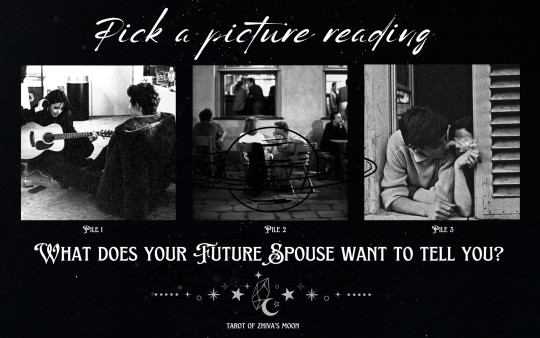
Hi! Thank you for stopping by and reading my work. I hope that you’re going to find the guidance that you need🫶🏻 You can now book a reading with me! Visit my services here and just message me if you are interested in booking any reading.
Pile 1
It took us a while to fall in love, to let each other open up to this possibility that maybe we are meant to be together because old habits kept coming back, they kept influencing our ability to open our hearts and they hindered this beautiful fresh start of a new beginning for us, as we came into this with suspicious and cautious eyes. I must say I lacked experience in relationships, it took me a while to understand how I am supposed to show up for you, how to actually be able to make you part of my routine, but it’s all so clear now that I can push past the limitations of my past. My heart is open to you, it is open to love and inside of me there’s a constellation of feelings that I feel for you because you just bring out the best in me, a part of me that I never really knew existed. I have tried to hide behind the shadows of my defense mechanisms, of every behavior, thought and action that I took with the idea that I needed to take care of myself and preserve who I was in case someone else wanted to conquer me, take everything and leave me with nothing but with you all of my defenses dropped. I can’t think clearly when you’re around, I can’t even describe the things I am feeling when your soft skin touches mine but I know that I am surrendering to you; you can have all of me, you can take over everything I am because I completely trust in you that you do not want to change me, I trust that you love me just for who I am and that whatever you’ll take, whatever I will give you, you will also give back to me so that both of us can grow beautiful gardens within us that are watered by our gentle, pure love. I want everything with you, I want to see the end of my days next to you, I want to start my mornings and end my nights with you here, with a kiss, a touch, a smile and other tokens that symbolize the absolute love we have for each other.
If you enjoyed this reading, the full, in depth reading is available to read on P@tr30n which you can find in my masterlist pinned post. Thank you so much for your support💗
Likes and rbs are appreciated🦋

Pile 2
I have walked alone for years and years, always leaving parts of me everywhere I went, something that people could remember me by or it maybe was because I had lost so much of myself in that relationship of place that I didn’t know what was mine to take. I have always been one to want this world to become a more loving place for everyone, I understood and observed others, saw their pain and I took it on me to the be the person that is always there for them because I thought they needed me, even though I was also hurting on the inside and no one actually really saw me. I didn’t want to fall in love ever again, I wanted to be on my own because I felt that I had a bubble of protection around me that no one would be able to break if I didn’t let them get too close to me, I just didn’t want to surrender to such a powerful, yet possibly extremely hurtful experience if it wasn’t meant to work out; I didn’t want to take that change at being heartbroken anymore because I felt like if it happened it would have turned me into this cold hearted monster that had no empathy, no understanding and no love to give, only madness at a world that seemed to be against me and never showed me the love that I needed and wanted in return. I have been in my own world, my own safe space, like a little scared rabbit I would hop in and out of relationships and places the moment I started to feel vulnerable and threatened, nobody was really able to catch me and to show me the love, show me the way back towards a part of me that I actually lost in the process of trying to protect my heart. You were able to make me want to stay next to you because you have been so gentle with my heart, you have actually a better understanding than me about the things that I was going through because you’ve been through similar experiences but you still turned out differently, those experiences actually transformed you into being even kinder, even more loving and your energy has showed me the way back to myself.
If you enjoyed this reading, the full, in depth reading is available to read on P@tr30n which you can find in my masterlist pinned post. Thank you so much for your support💗
Likes and rbs are appreciated🦋

Pile 3
I threw logic out of the window with you, I didn’t need it and I don’t think I will ever need it because I knew that I needed to let my heart guide me to you and guide me with my relationship with you. I manifested you, I spent entire days thinking about you and wanting you to find your way into my life so that I could experience this type of psychedelic love with you, one that lifts me up to the sky on soft clouds and makes me feel lighter than ever, like I have no other worry in the world. Your love is spiritual, I do think and feel as though you have a spiritual purpose in my life, this romance isn’t simply practical, it isn’t a simple “this is what I need to do, this person is good for me”, it’s more than that, it’s deeper and besides that feeling that you are the one for me, there is something that doesn’t really make sense. And it’s beautiful that it doesn’t make sense, because we are nothing alike, we see the world differently, but we want the same thing which is love and growth. My prayer has been answered when you came into my life, romance found its way into my life in the most elevating way and I knew right from the start that I was going to marry you because it was the only path our connection had as an option. I’m here to work hard for you, I’m here to work hard for our relationship because I know that the effort I put in matters and I know that it makes a difference towards actually achieving the beautiful things that we both want out of this connection. I know that both of us are going to be successful because everything we need is right in our hands. I know that sometimes these feelings can get overwhelming and sometimes too much, even if it is love, can do great harm if it transforms into smothering and being too present, I am guilty of that, I’m guilty of wanting to spend all of my time with you, guilty of doing everything with you but I also know that we should maintain this sense of independence for us to be able to do things outside of the relationship too because it’s healthy.
If you enjoyed this reading, the full, in depth reading is available to read on P@tr30n which you can find in my masterlist pinned post. Thank you so much for your support💗
Likes and rbs are appreciated🦋
Dividers by Kawaii-Lau on Tumblr

#Spotify#pac#pick a deck#pick a photo#pick a picture#pick a pile#pick a reading#pick an image#pick a card#pick a group#tarotblr#tarot blog#tarot witch#tarot reading#tarot cards#shufflemancy#aries#taurus#gemini#cancer#leo sun#virgo#libra#scorpio#sagittarius#capricorn#aquarius#pisces#relationship#fs reading
242 notes
·
View notes
Note
PLEASE do the toontown online rant i want it so badly
this post kinda got away from me, and by "got away from me" i mean this 3000 word toontown rant is Part One. there will be a Part Two to this later in which i actually talk about the fanservers i wanted to talk about. anyway let's go
toontown online (tto) was a children's mostly-turn-based subscription MMO released in 2003. after a few years of obviously being on life support, disney gave a one-month notice that tto (and several other games) would be closing on september 19th, 2013. on the same day the game closed, the fan-run server toontown rewritten (ttr) was announced (with multiple other fanservers/fangames/reimaginings being established since), and is a few months away from outliving the original game
see, one thing about tto that allowed fanservers to crop up so quickly and easily was that it had, um, interesting choices. very interesting choices. like, "kids could use a code injector to turn their backyards into giant mashed-together nightmarescapes"-level choices
youtube
(loose video description: a rabbit toon running around a chaotic mismash of rooms, obstacles, and npcs that Should Not Be There. audio caption: Evanescence's "Bring Me To Life".)
but ok let's talk about the actual game first.
toontown online (tto)


the game starts with you creating your player character - you can pick from eventually-9 species, a couple body types, and 2 dozen preset colors. the gender code is a spaghetti nightmare but you won't learn this until the fanservers come about so don't worry about it. you're then taken to the Toontorial, which explains maybe 20% of the game's mechanics before setting you loose into the main game
the toontorial also gives you the basic "plot", such as it is: Toontown is suddenly* under attack by a bunch of boring businessrobots called the Cogs. their goal is to turn toontown into a dreary gray featureless corporate hell; their business activities are so boring that they're physically painful to be around. luckily, they can't take a joke, so the toons have figured out how to defeat them: by playing pranks on them until they laugh so hard they Explode
*originally, the game installer had a little animation giving a backstory for the Cogs' creation. this was never referenced in game, removed pretty quickly, and i think even the devs kinda forgot it existed
that's...pretty much the whole story! in that context, your toon progresses through all of toontown, helping some mostly-pretty-interchangeable shopkeepers, reclaiming buildings from the cogs, eating ice cream, etc. occasionally, the cogs would Come Up With New Tricks (read: major content update) and the toons would Find A Way To Fight Back (read: same major content update). that was the closest thing to Plot, unless you count "the devs scheduled a bunch of invasions of high-tier cogs right before the game's closure". but...i doubt most the kids really expected a Plot. mickey mouse was there
the gameplay:
the Free Account
there were two...pretty different approaches to playing toontown online. when the game launched, there was a 3-day free trial to the entire game, after which you got kicked entirely until you subscribed. at some point, this was changed so that the first area, Toontown Central (TTC), was Always Free - you could do all of that area's quests/"taskline" and limited activities, indefinitely, and in theory this would make you beg your parents for the rest of the game
i have no idea if this actually got more subscriptions or not. from what i can tell it just spawned more warrior cats
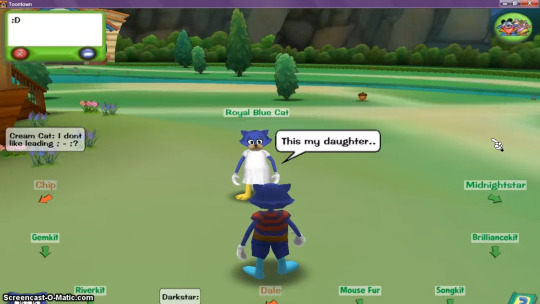
(source)
there were. a Lot of warrior cats. there were some other social activities, too, such as Fashion Shows (with your limited range of clothes) and Begging Subscribed Players To Summon Cog Buildings To TTC and Getting Chat Banned. ...however, as one of the subscription kids i didn't really interact with this side of the game, so i'm not the best person to talk about it
2. the Paid Account

mmm look at those crisp clear graphics. hell yes
a subscription account gave you access to this whole map, along with all these areas' tasklines. to progress through the game, you must complete a variety of "ToonTasks" for the Toon Resistance (it's called that. their catchphrase is "Toons of the World, Unite!". you were giving disney money for this). these reward you by increasing your max health (your "Laff Points"), slowly unlocking more combat options, and sending you to different, higher-difficulty areas of toontown

some of these tasks were...longer than others. generally, though, they all boiled down to: "just go fight some cogs"
combat:
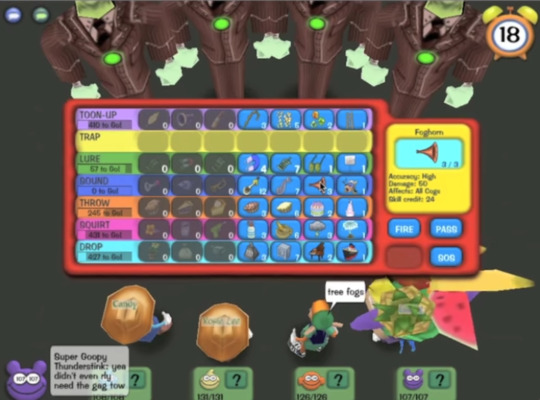
(source)
toontown battles are turn-based: the players use their attacks ("gags") first, and then any surviving cogs attack you with, usually, office equipment and puns thereof (unless the cog is e.g. a Loan Shark, in which case they can just fucking bite you). if you defeat a cog, it explodes; if the cog defeats you, you "go sad" and are sent back to the safety of the playground, lose your gag inventory, and can't leave until you heal.
early on, most your battles are 1v1, but later on almost everything is a multiplayer 4-ish-v-4.
an...interesting feature here in the game's early days was that you could only Type Your Own Words to someone who shared their "friend code" with you IRL. otherwise, you had to use this thing:
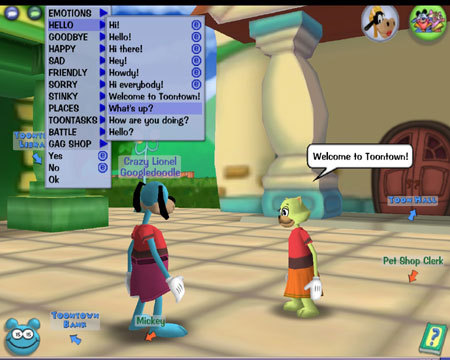
(source)
you had a set list of phrases you could string together, which generally covered most the things you wanted to say. but it could get frustrating when you wanted to have a real conversation with your toontown friends! so...as the source above mentions, people obviously found ways around the system. turns out that if you let players move objects around their houses, they will use that to Draw Letters and pass their friend code along regardless
eventually - before the warrior cats, of course - disney presumably realized this system was pretty goofy (🥁) , so the game got a real chat, albeit one that functioned on a very strict whitelist. my favorite is that it didn't let you type numbers, however you could just say won too tree for hive etc. like. disney i really don't know what to tell you. anyway
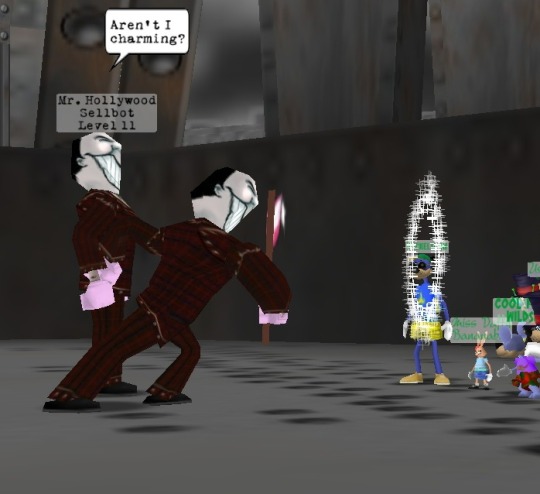
(isn't he charming)
cogs come in levels 1-12, with levels displayed above their heads, and as you'd expect their damage output and HP increase with their level. however, the game doesn't...actually show you cog HP? instead they have a little colored light on their chest that fades from green to red until they explode. you see numbers on all the damage you do, and you see your own HP/laff, but never the cogs'. also lategame cogs are Too Tall For You To See Their Level once they line up for battle (which isn't actually that bad but it's funny). there's a formula for HP per level, but it's never mentioned in-game. i guess someone can teach it to you but then you have to watch them type "a level tin cog has won tree too health" and is that really worth it
(as you can tell i just…don't get this. "my kid is practicing arithmetic with toontown!" - marketing angle expressly denied by god. the stealth edutainment was right there)
anyway! in theory, you have seven base combat options ("gag tracks"), which combine in a variety of ways:
toon-up, which restores your teammates' health;
trap, which does guaranteed high damage but only if someone uses lure;
lure, which stuns the cogs for a few turns and is the only way to make trap work
sound, which does low damage to every cog;
throw, which does medium-high-ish damage to one cog; multiple throws combined give percentage combo damage, and hitting a lured cog will also add percentage "knockback damage";
squirt, which is exactly like throw but less damage;
and drop, which does high damage but cannot hit lured cogs, and has low accuracy unless you hit the cog with something else first
each gag track has 6 levels, which you unlock by using that gag track a bunch. you can't carry as many of the high levels with you - i mean, putting one piano in your backpack makes perfect sense, but two is just silly, right
a few years into the game's lifespan, level 7s were added - these were huge AOE that you could regain with every 500 track EXP. there was also something called "organic gags" to promote the please-log-in-every-day gardening system
every player starts with throw and squirt, and throughout the game you slowly unlock four more gag tracks. your choices are permanent: once you have your six tracks, you're locked out of the seventh forever.
in theory, all of this opens up a huge variety of combat options!
in practice, the battle strategy looks something like this:
use sound
as mentioned, almost all of lategame will be 4v4 battles, which means sound will almost always outdamage everything on earth. you don't even need four foghorns (the highest normal sound gag) to break 200 AOE damage, and the highest health a cog EVER has is 200*. and two of the boss battles can reward you with gag restocks and heals that you can use mid-battle with no consequences (other than having to grind for those rewards a bunch). and failing THAT, you can just...ration your foghorns and take 2 turns to clear a set of cogs, interspersed with healing.
(*okay there was something called "v2.0 cogs" but they were...strange, and we just used sound anyway)
sure, once level 7s were added you could use those occasionally. and you could fall back on lure+throw if you didn't want to use your sound restocks. but even then, for most of tto's existence there was something called the "knockback bug" which. well. just look at it
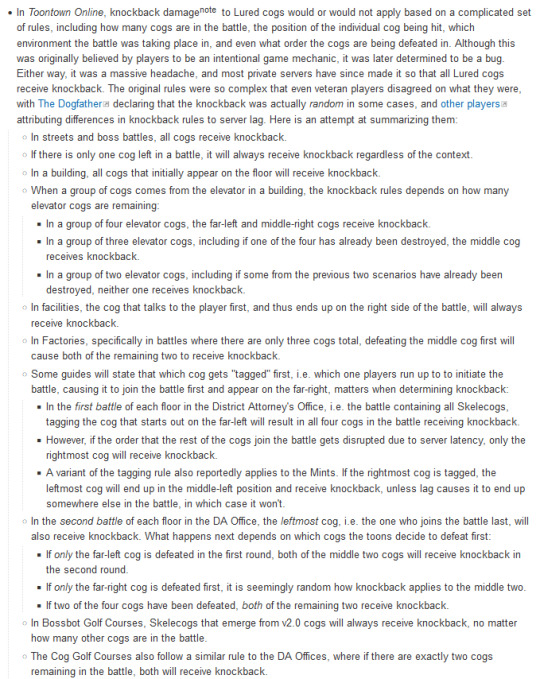
(link for transcript. it's tvtropes sorry)
if you are a target-audience eight-year-old this translates to "lure + throw will only do enough damage if the cogs Feel like it." like it's really just insult to injury at this point. this was the result of One misplaced variable and was not fixed until the game closed
in the tto era, if you didn't have sound, you were kinda doomed to be kicked out of every fight forever
(bonus fun fact: there were Four entire battle themes and they were 40-second midi loops. let me out)
the bosses:
each of the four cog departments has a Boss Cog. to face off against them, you have to assemble a cog disguise and collect enough merits/stock options/whatever to be allowed into the boss's office.

(pictured: your convincing disguise)
when you enter, your disguise pops off due to Reasons, and you have to fight through...a bunch of waves of normal cogs. it's basically a really long normal battle. once the minions are dealt with, you have to, inexplicably, do a live-action battle against the boss themself:
youtube
(loose video description: four toons defeating the CFO by using magnet cranes to hit him in the face with safes for 32 seconds.)
the live-action rounds aren't supposed to go this quickly, but it's still...kinda strange? certain reoccurring game areas require Parkour, but there are no battles like this outside of the Four bosses. the CFO's room is the only place you see these cranes and they have A Lot Going On. the other 3 bosses have their own unique weird mechanics. before the first boss was added we neither had nor needed the ability to Jump. it's just weird
once you've defeated the boss, you're given a reward of varying usefulness (the best/most unbalanced reward type is Unites, which are a free heal or gag restock you can do inside or outside of battle. essentially lategame toons can simply choose not to die. riv2u etc.)
and, um. then you get some more merits/stock options/whatever and do it again. and again. and again. and again. and agai
the grind:
so the thing is that tto was a subscription mmo. every addition to the game had to be measured, above all, in terms of "how can we best get kids to beg their parents to give us money." this especially shows in the suit grind:

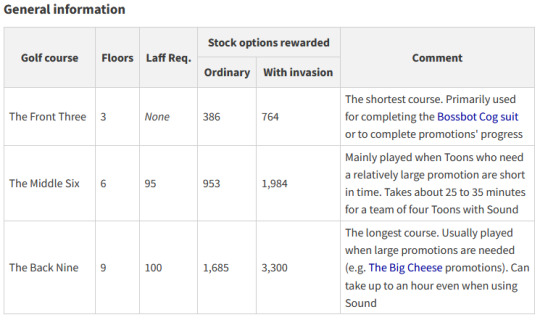
(source/source)
you have to defeat each boss 78 times in order to get all their laff points - and as you proceed, you have to defeat an increasing amount of cogs to even be allowed into the boss (although once you max you get in for free).
by far the easiest way is to run through the designated HQ facilities - basically, cog fights interspersed with some platforming or minigames. you only collect your merits/whatever at the Very End of the facility. the only way to increase what a facility gives you is if your last battle ends during an "invasion" - a timed period where One Specific Cog replaces all street cogs, usually summoned with boss rewards.
the sellbot HQ grind isn't so bad. bossbot HQ - the endest-game HQ - frequently requires you to do an hour-long facility and on six separate occasions you have to do seven of them. if the invasion ends before your final battle, you have to sit around until someone summons another. if you lose your internet connection because it's 2008, or if your parents make you come to dinner, or if hacking or the game's general bugginess cause a server reset because you're probably in the busiest district for the invasion bonus, you have spent that Entire Hour On Nothing. the CEO (bossbot cog boss) probably also takes an hour because you and your fellow players are 10
this shit, combined with laff points locked behind gardening (time-gated), racing and golfing (multiplayer minigames with absurd requirements), and fishing (RNG-based with some fish being absurdly rare. i watched my mom fish for one every day for a month), meant that maxing a toon took Years, if you managed it ever.
it wasn't, um. it wasn't good
ok so what else is wrong with this game:
i had "aged out of the game" (lol) by the early '10s, so i'm not the best person to do a writeup of the hacking/scripting situation of those days. that said, what i'm going to do is give you a few examples, and i want you to just...look at them

(source)

(source). early '10s youtube was funny i'm trying to decide if i miss it
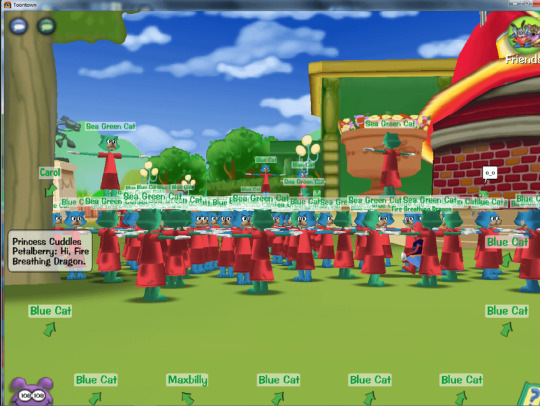
(source). fun thing to note here is that other players had collision, so a swarm of t-posing toons could just barricade the gag shop if they wanted to
youtube
(video description: toon who has Replaced His Head Model With An Anime Logo throwing thousands of jellybeans at everyone) (cw mild flashing just in case? and also the feather headband accessory)
i should note that the Bring Me To Life vid i started with was client-side, meaning only the player could see their technicolor hellscape. this guy's face was server-side. i do Not Think you should be able to do that
youtube
(video description: a player demonstrating use of a bot to get into the nutty river district, followed by other players using it to go to different game areas)
the above video was posted on august 17th, 2013. if you don't want to watch an Unregistered Hypercam 3 recording at about 5 frames per second, what's going on here is:
the player goes to a specific location and says a specific speedchat phrase.
a bot toon teleports to their location and provides some prompts on how to use it
the player tells the bot, via speedchat, to teleport to the (currently closed from the outside) busiest district so the player can follow
these "taxi toons" were server-sided, persisted across server resets, were made by a future fanserver dev, had younger kids referring to them as a "glitch" as if this were something that could Accidentally Happen, and stayed functional until the game closed
like...a lot of the "hacking" was just baby's first script download. this one - afaict also created by the laughing man head guy - is like...the fact that after years of no substantial game updates, someone effectively programmed their own "QOL feature" (note: not actually good for the poor mid-00s server being turned into a clown car) into a silly disney MMO and it just fucking sat there for a year is just. it's just.
i don't know what this is. this is not Playing The Game Toontown Online. this is nothing. this is everything. there are comments from 2013 on some of these videos saying stuff like "hackers killed toontown", but your game cannot have this happen if it is not already dying
and, like...it was. i'm not sure how many moderators there were by this point, but at the very end of tto, the number of active devs was One. the original devteam recently brought this up at the 20th anniversary celebration: devs just...slowly started getting pulled from the game, one at a time. there were a few updates after bossbot HQ - Field Offices, which i've basically never heard anything good about in their tto form ever; the Silly Meter, a yearly event...thing whose main function was to add unskippable dancing-inanimate-object cutscenes to your street battles; Parties, which...yknow parties were okay actually. i accept parties. but they weren't exactly a Major Game Update like the ones that had come before. in 2011 we gained the ability to Wear Hats. in 2012 the test server got some actual QOL updates that never made it to the main game; the final test server update was some maintenance in february, and then nothing for 18 months. disney was not providing enough resources to address the scripting because disney was not providing enough resources to address toontown. imagine being the last dev standing on an MMO that was older than some of its players, was losing its business model to mobile gaming, and spent most of its life falling apart at the seams. just imagine it, for a second
it couldn't have kept going, not like this.
on august 20, 2013, the closing announcement came: we had a month left of toontown online. the test server shut immediately; subscription refunds went out, and the game became actually F2P for the month; the part of the announcement that went like "we're shifting our focus to other games!" made a bunch of twelve-year-olds hate club penguin as if club penguin wouldn't also close in a few years; all the holiday events went off at once; and...

there wasn't a "thanks for playing!" popup. everyone online just got kicked, all at once. it was finally over

hey wait.
#toontown#toontown online#tto#tft talks#tft stuff#<- this goes in that tag i think#this was like. enrichment. thank you
243 notes
·
View notes
Note
They pointed a gun at Aaron. When there was a self immolation in December, the authorities spoke about it as if it was a form of antisemitism.
I have said it before. I will say it again.
It is an act of despair and feeling like nothing else you can do will be heard. Nobody burns themselves alive out of hatred.
Nobody.
I truly believe it was an act of grief. it was an act of fury. but i want to stress that it was not an act of hopelessness. like i said before, it was not just suicide, it was a calculated political act made by a determined man of sound mind and body who decided to use his death to send a message. he burned himself in front of the embassy in uniform because he knew that in the eyes of the US government, his life was worth more than the lives of Palestinians. His death was a deliberate attempt to call attention to the deaths of the thousands upon thousands of innocent people in Gaza. the point is that every death an inhumane brutal unconscionable horrific end to a real human life. the point is to disturb. the point is to be seen and heard and felt. he died screaming for Palestine.
like i said in another post, I took a class violent and nonviolent protests as an undergrad, and we talked a LOT about self immolation, and the work / thought / motives / grief / anger that goes into something like that. I’m gonna link a few articles if anyone is interested, I know it’s a really heavy subject but I also think its important to understand the role the act of self immolation has played in the history of protest:
this is about religious activists (both quakers and buddhists) who self immolated in protest of the Vietnam War
this is about the terminology we use to talk about self-immolation (specifically about the self immolation of tibetans in Protest of Chinese occupation) and about the objectives of political self immolators
and lastly, i am telling EVERYONE to read Weird John Brown: Divine Violence and the Limits of Ethics by Ted A. Smith. it’s not about self immolation, but it is about the use of violence in systemic oppression and resistance and deals with the question of Who Defines What Violence Is (spoiler alert: the state defines what violence is, and the definition will always stretch to include the actions of the resistance and exclude the actions of the state). it is a really in depth and succinct examinations of the mechanisms of state sanctioned violence, and its HUGELY relevant to everything that’s been happening. PLEASE read it. everybody should read it. i don’t have a link to a pdf but im sure you can find one, or get it from a library or bookstore. it’s worth having, honestly. go read it.

#free palestine#self immolation#aaron bushnell#abolish the police#okay idc if you skim what I wrote in this post but it would b cool if u could reblog this post for the links cause i do want people to see#and maybe read the articles / check out the book even if they don’t read what i have to say#what i have to say isn’t actually as important
110 notes
·
View notes
Text
What is XP for?
It feels like there’s been a recent spate of discussion in RPG circles about the role of incentives (usually just referring to experience points, or XP). While a lot of that discussion has been mean-spirited (with a lot of conflating preference for “the only correct way to do things”), I would like to contribute by try to describe the role of XP is in modern tabletop RPG design, using Blades in the Dark as an example. If you’re a designer or a player, hopefully this helps you think about the role of a mechanic like this.
1. XP paces out advancement
This is probably the number one reason that we have XP in games. Historically, in this hobby, games have offered players to way to advance their characters, letting them grow in a way that makes them more powerful or interesting. For example, in Blades in the Dark, by requiring 6-8 XP to upgrade your character, the game paces out the process of getting new abilities to around every 2-3 sessions or so. By tweaking the amount required, it could’ve made this process shorter or longer.
The primary critique of this use of XP comes from people who question whether advancement is necessary at all. These usually come from folks who are who are either perfectly happy with their character “improving” in non-mechanical ways (like buying a house in-game) or people who prefer changes rather than improvements (getting a cool scar rather than getting better at punching).
2. XP as recap procedure
As Judd Karlman mentions on his blog, having an end of session xp procedure is a way to give everyone an opportunity to “think back on when they were kicking ass or being cunning – remember it and celebrate it while ticking off a box”. The idea is that the end of session procedure becomes a kind of ritual to share your favourite highlights from the session, aiming to deliver a good note for the game to end on.
3. XP as incentive
Some games use XP to encourage players to do things that they might not ordinarily do. This is quite common in the kind of games that I play. For example, in Blades in the Dark, you get XP when your character is in desperate situations. The game is trying to encourage players to take risks as opposed to playing it safe (because they might be coming from games where taking risks was less fun).
These kinds of incentives are usually criticized for two main reasons. One, it is unnecessary, i.e., it encourages behavior that needs no encouragement. Two, it has a negative effect on freedom of roleplay by pointing at a “right way to play”.
Stepping back for a second, I think these are both good criticisms that can be more or less valid, depending on the specific game or style of play. In my experience, in general, they’re least valid when they are theoretical, armchair criticism and tend to be most valid when they come from direct play experience.
With Blades in the Dark specifically, I think XP for taking big risks does lead to players shifting gears and playing differently. Not by itself though! It works because it fits within a whole system meant for that kind of story. The XP is just a tiny little signal.
As for narrowing the realm of roleplay, I think this is broadly true of hyper-specific storygames. They are a kind of game that actively tries to provide constraints - but in the same way a writing prompt is a constraint. It’s hard to be creative without them! Some of these games - not all - tend to involve some amount of discovering who your character is, rather than coming in with a specific idea.
That said, it can be frustrating in Blades in the Dark to pick a playbook with a particular character concept in mind and find that you’re out-of-sync with the game’s XP triggers. This kind of misalignment can happen, for sure, and it is a limitation of Blade’s specific design. The solutions tend to be some form of hacking or just switching playbooks. But even with that frustration, I would hesitate to say it’s a problem with XP as a mechanic though.
Though XP doesn’t actually need much defending - like so much of game design convention, the main reason games will continue to include it is because games have always included it. Players have come to expect it! But at the same time, I think XP can always do more and be more (or less!) than it's currently doing. I’m excited for people to look at these functions of XP and innovate, keeping what excites them and finding ways of changing the rest.
(This was first posted on the Indie RPG Newsletter.)
245 notes
·
View notes
Text
I don't feel like q!bad gets enough praise for being such a good dad.
Like, he's encouraging of Dapper's special interests even if they're dangerous and often end up with him at least slightly hurt. He's incredibly respectful of Dapper's independence while also being a caring and attentive father. If they're going to be out and about together, he almost always takes Dapper's input on where they go and what they do.
He knows Dapper is talented player, who knows more than he does sometimes, while still recognizing when Dapper forgets his own limits. He's still a kid, and a fragile one. But that doesn't mean putting him away in a box, like Phil has done with Chayanne. That means finding ways to be safe, having extra backup plans, extra people you trust by your side. They're on together almost every night, even past or before streaming times.
Bad is the egg babysitter, he goes out of his way to do things for them because he genuinely is such a compassionate person. He's also dedicated to solving the lore, to pranking his friends, to building Skeppy statues, and everything else.
Dapper is the mechanic, a collector who isn't ashamed to help others and leave them a gift or a silly prank along the way. He's a kid, who fights with his dad and keeps a journal of how all his machines work, just in case.
A lot of times, when people want to thank Bad for his help, they wonder, "what do you give someone who has everything?" And truth be told I have no idea what I'd do. It never feels like Bad has everything, but rather, it feels like he has everything he really wants. Bad has Dapper, and together, they're able to accomplish almost anything. That's what I think makes them so compelling.
I occasionally scroll through Twitter and see people talking about how they want the egg event to end. I can respect that to a degree, I think it's ended up with some streamers quite stressed, tired, or receiving harassment. However, I feel like Bad and Dapper are the perfect example of why you can't just tear the eggs from their parents - Dapper is as much a character as Bad is. They're a duo, they compliment one another in their skills, their personalities, ect.
It's Bad and Dapper against the world.
And I really hope they find a way to allow them to stay that way.
#qsmp#qsmp dapper#qsmp badboyhalo#q!bad#qsmp eggs#god I love them so much okay#I was so tempted to be sad in post but Ill do it in the tags#When Bad was showing Forever his farm#he asked if Bad lived out here all alone#to which Bad responded it was him and Dapper.#If Dapper truly does go away#Can you imaine Bad being out there. so far from everyone else so disconnected#all alone? without his link to the world. without his pranking partner and the one who understands how all the machines work#Most of the server doesn't have his waypoint saved!#Who's going to support him through the fall? Who's going to be there to pick him up in the way that the rest have each other?#Gosh man. these eggs.
343 notes
·
View notes
Text
Act 1, and Leshy's relationships with the other Scrybes
There was a post on here a while ago about Leshy outright hating Magnificus more than P03, and one interesting observation was that he cuts the Wolf's stats, but boosts the Stoat's. I think there's more you can gather from Leshy designing around the other Scrybes, though:
GRIMORA:
Leshy seems to be the most amiable with Grimora. Yes, I think this probably comes a bit from the dev finding their aesthetics and gameplay styles easier to pair up, but I think's its also a little bit because she values fun quite strongly, which meshes well with his focus on lore: both things that aren't purely gameplay based unlike the weirder mechanics of the west-side Scrybes.
Similar to Leshy in act 2, none of her puzzles really cause any harm to her subordinates. It's meant to be some fun flavour plot for the player to engage their brains with before the battles. Honestly, the amount of times she says 'Marvelous!' alone should convince you of her priorities (outside of destroying the world!)
Leshy goes out of his way to design a totally new card for Grimora, which doesn't appear anywhere in act 2 or Kaycee's mod.
It's the only one with a sigil on it - it's a fragile card, but it requires more actual strategy than playing the non-sigil Wolf and Stoat.
One line of dialogue remarks that he wishes he had kept Grimora around, as she was at least a worthy challenger.
He says that the Stinkbug is weak, but other than that accepts you having it in your deck. Compare that to him absolutely hating the Stunted Wolf on sight.
If you look closely in the finale, Grimora has an insect crawling across the table in her campaign. I don't know if it's really a stinkbug, persay, but it's an interesting parallel to his choice of her species.
Someone has said before that there are notably more insect cards than any other species in act 1, which also plays into him being closer to her than the others.
Bones are literally the secondary currency in his campaign, whereas energy doesn't appear at all, and sigils are limited to a single map event.
stinkyyyy
MAGNIFICUS:
Between Leshy actively saying he hates Mag's card once you first get it (versus one line about the Stinkbug being weak), and him literally stabbing the guy's eye out, it's safe to say Leshy fucking hates this guy. I've seen different theories on this, between the clashing gameplay and Leshy being kinder to his subordinates, but the one I've thought was the most interesting was that Magnificus is arguably, the most powerful Scrybe.
He's the only one who does have a plan to get Leshy's takeover back to normal, and the other two Scrybes are desperate for you to find him in act 1 because of it. He has future vision, he writes letters to the others warning about potential takeovers, and you never see him scrounge for the OLD_DATA. correction in reblogs: i think it is mentioned that he has
I've always read Leshy's feelings towards Mag as jealousy, mixed with clashing ideologies. I don't think there's a single moment where the two agree on anything outside of act 3.
I don't have much to say on his card, gameplay-wise, as you get it very late. Honestly most of the Stunted Wolf's design is just foreshadowing that Leshy beat this guy up and stabbed out his eye, lmao, but it's still interesting to note that:
The Stunted Wolf is one of those cards that's a variant of another one (i.e. Wolf Cub/Wolf, Mantis God/Mantis), but it's notably the only one whose stats are worse than its predecessor.
At the same time, it only costs one blood, and it's the only 2-attack card to have that. Gameplay wise, this is to balance things out, but it hints towards Magnificus having been much more powerful in the past. Like it makes you ponder how fucking good it would be to start off with a one-blood 3-2 card.
Magnificus's only other gameplay feature in act 1 is the sacrificial alters (given his association with magic and sigils). These are fucking busted. God I wish I could have four sigils on a card in Kaycee's mod.
P03:
Leshy seems to not think very much of P03 (both in the sense of not acknowledging it and thinking it's not a good designer), but doesn't seem completely unwilling to work with him. I'd argue he's not really hostile towards P03, just very aggressively trying to push it into his own ideal of the world.
In Kaycee's mod, Leshy refers to him as a rival and not an enemy, which I think gives a good basis for interpreting how he views it. P03's breakup speech snapping at Leshy in act 2 is ultimately what gets him to question his intentions at all.
The mention that the stoat's suffering was real during the tutorial isn't really ever brought up again by Leshy. It's interesting to think about in hindsight, given that P03 being a robot means its the least likely to have experienced pain out of the four.
Combined with P03's remark that Leshy keeps him around just to suffer, and the later remark in act 2 that he thinks that it is noble to be a beast card, "even one as lowly as a stoat," this implies that Leshy's at the very least trying to get P03 used to his world, and almost hopes that he'll come to like it.
The unbuffed stoat is a really terrible card. All the 1-2 cards have some sort of gimmick to them to make them playable, but the normal stoat just doesn't at all. The buff to 1-3 is a gift from Leshy to P03, despite everything. It implies he at least thinks there's something that can be salvaged between them, in his own view.
And like. The buffed stoat is so so useful in act 1. The extra HP means it can take a hit from so many more cards and it's a solid foundation for basically any run.
The stoat's the only one of the talking cards without an animal family. Of course it is! Nature and technology are usually thematic opposites, especially compared to magic and death. P03 doesn't fit in here, but Leshy is still clearly trying to make it a foundational card in his campaign.
#inscryption spoilers#inscryption#inscryption analysis#inscryption leshy#dots dots dots#i may have needed to rewatch the finale bc i was unsure if the stinkbug was canon or only a grimora mod thing#anyways idk if anyone will read this but these guys are so fascinating and I need an actually decent take of them out on tumblr#so i guess i will have to do it myself.
64 notes
·
View notes
Text
TTRPG Read-Through: Patchwork World
Here is a read-through I did last year (originally posted on Twitter) of one of the most unique PbtA games I've ever read: Patchwork World by Aaron King! - Christian
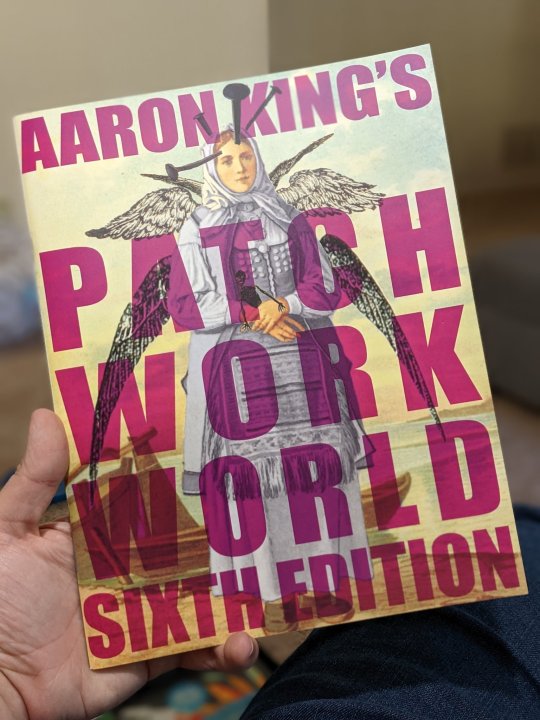
Credits up first. I know a lot of these folks and they are really cool! Excited to dig into this. I've heard good things, and it's been a while since I've read or played any Powered by the Apocalypse.
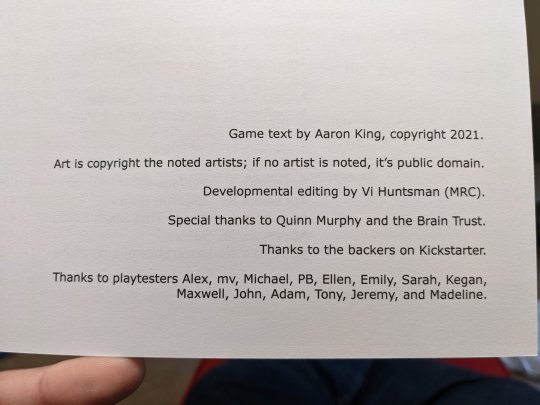
This is a cool, strong set up for me. I really like settings that ask characters to face a changing world and either take up change themselves or work to restore the old way of things. It's a headspace I find myself in a lot IRL these days so it's fun to explore.

I'm interested to see how the no stats, no playbooks angle of this game works, considering playbooks are typically such a staple of PbtA games.
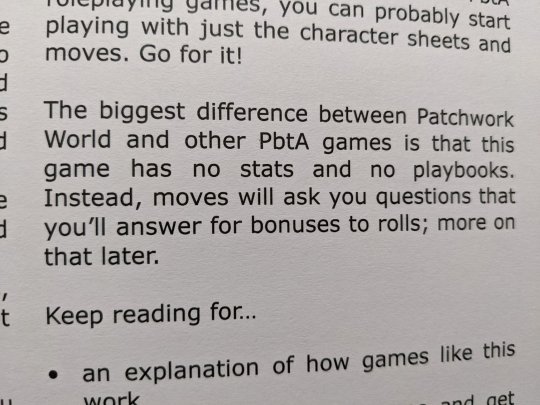
Standard three-tired success, mixed success, fail forward resolution for rolls here and questions on the moves determine your bonus to the roll. Easy peasy. +2 is the max bonus.

Other types of rolls are described here. Interested to see how they come into play. I also love clocks and use them in pretty much every game I run so it's nice to see those laid out here too.
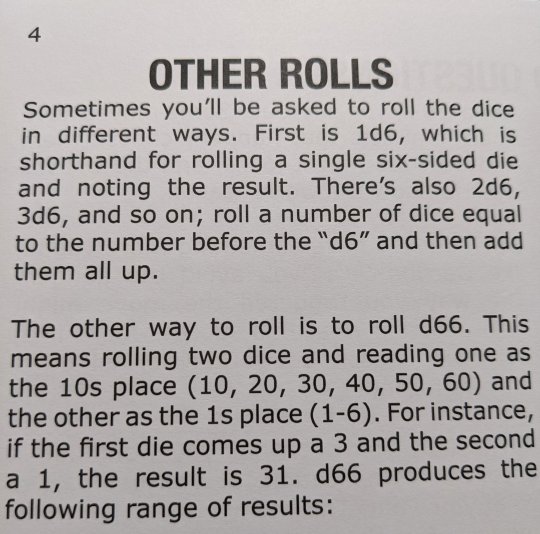
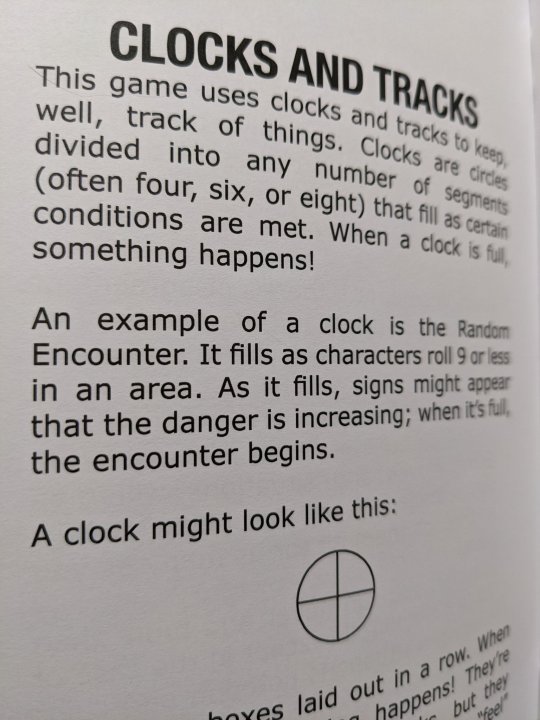
We just love a lil guy, don't we folks?
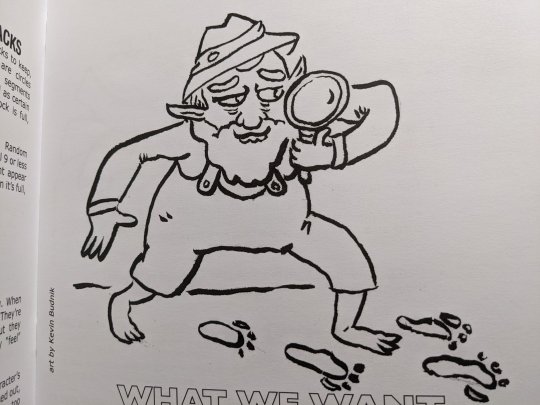
A good chunk of the opening here is spent on laying out a lot of solid foundations of roleplaying generally. It feels like a book (so far) that would work for entirely new players. It doesn't feel essential for me, but I never mind a game that supports varied experience levels.

Character creation is wide open, especially since there aren't playbooks and the text stresses that character creation is very much worldbuilding because of this. Fate-like concepts and tags are in here too which are things I generally enjoy. I like the Drawback mechanic.
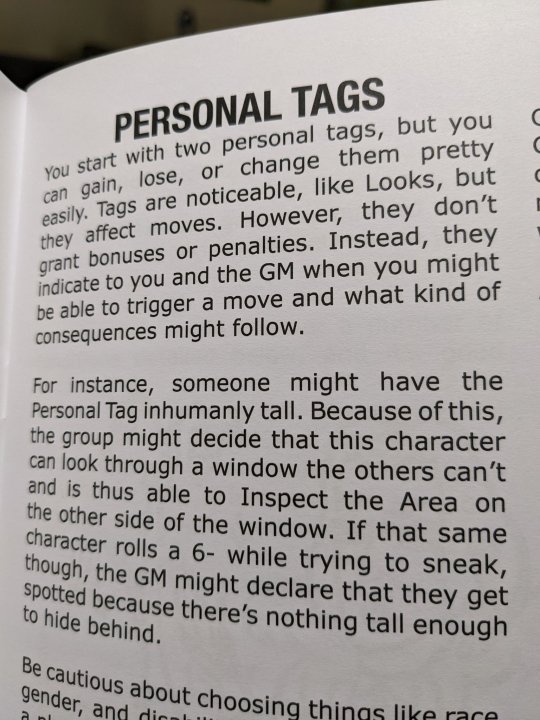
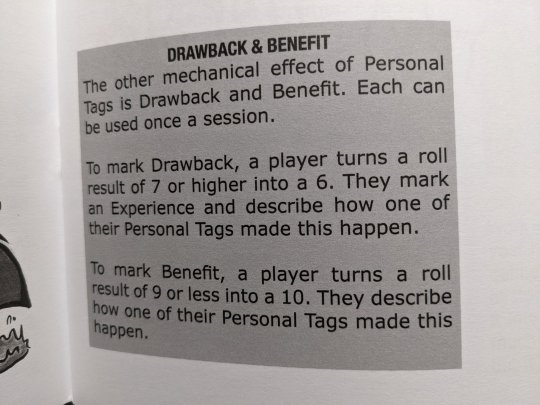
Moves are in the playback I set in the other room so I'm gonna go grab those. You get two chosen moves and everyone has access to a number of default moves. You've got three other life/XP things to keep track of too. I'm especially interested in Hex.

There are a lot of moves! They seem quite varied and often very weird, fitting well with the titular patchwork world. You can have a duck's slick soul to dodge more easily or a magical space suit or speak to birds or be good at cartography. Overwhelming, but in an exciting way.
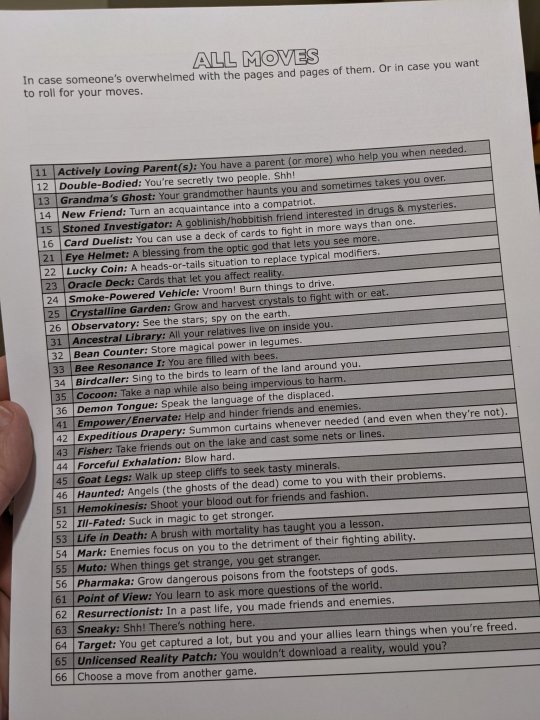
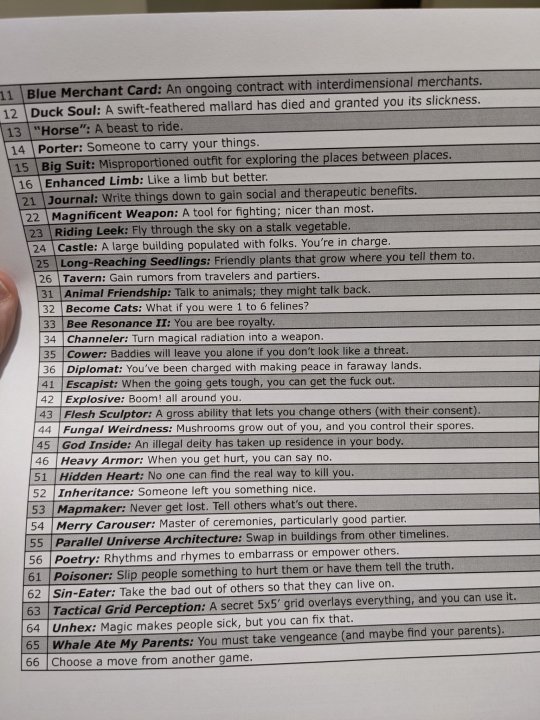
You also choose a community as a party. While PCs all have their original homelands (before the end of the old worlds), you know have a community that gets its own little sheet. This is a cool reshaping of the Gangs from Blades. I also like how the community can change over time.
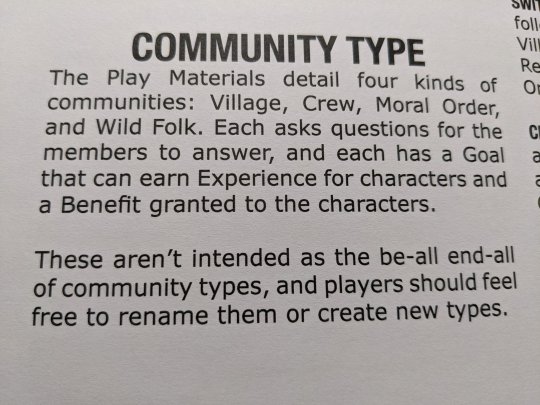
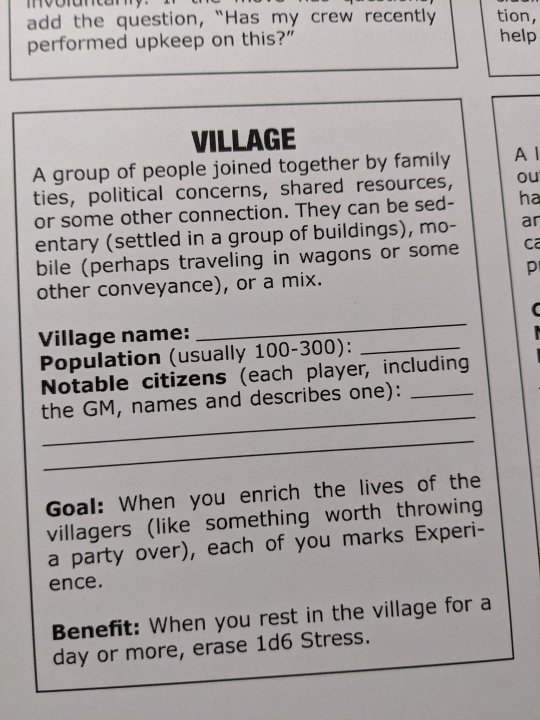
Coming back to a PbtA game after months of more OSR-minded stuff, I think a lot of what these games contain are things that experienced players would say you could just do in any game at any time that it makes sense in the story, but I do find value in stating what's possible.
Esp since many players come to games with artificial limits on their options (whether that's from video games, more traditional RPGs, etc.). I just think good GMing here requires making sure that the players don't limit themselves just to the bevy of explicit options either.
GM moves (mostly to guide the response to failed rolls). I really think the community aspect of this set up is one of the biggest appeals to me so far. That and the wild list of moves, which I'm sure makes for amazing parties of characters.

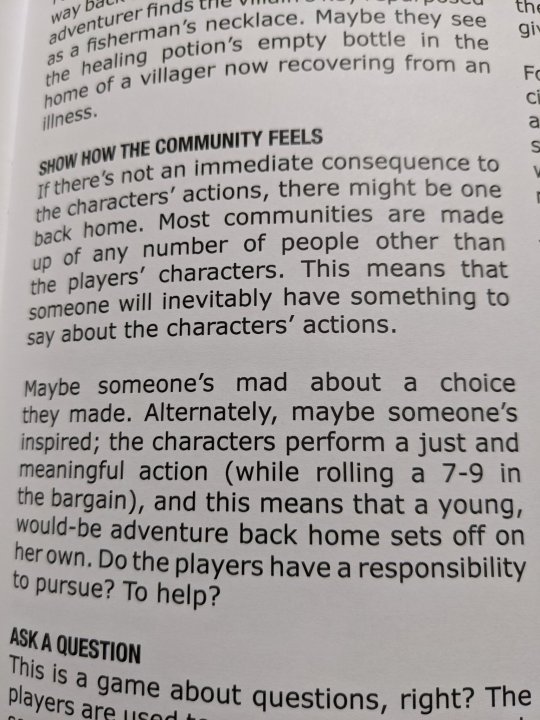
I always feel like it's never something I should be in my own writing (for some probably unnecessary reason), but I enjoy the first-person, casual writing style throughout the book. Makes for a very chill read.
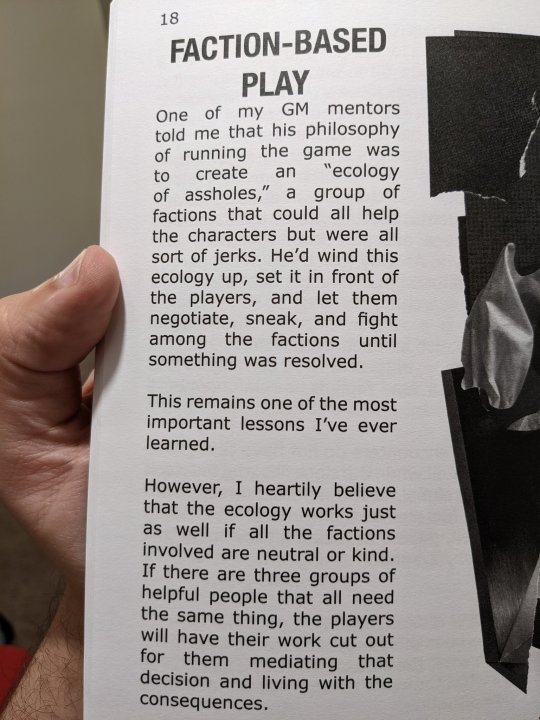
Good to see this game employs the Branson Reese style of NPC naming.

Stress acts as a single catch-all health and challenge rating for NPCs. Ideally, I'd hope this would help lead to the PCs approaching encounters with more than just violence.
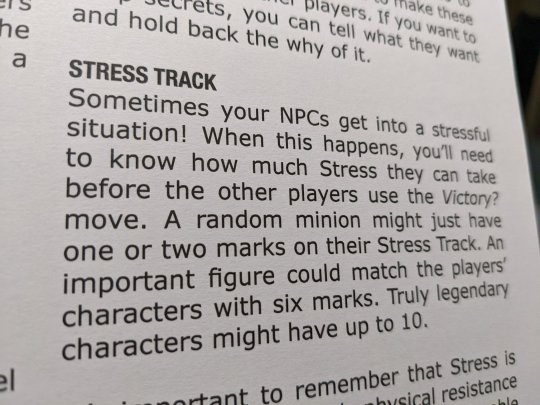
Sections like this are what I'm referring to when I say this book feels very friendly to new players. It's got little anecdotes and thoughts like this throughout.

Look, it's been a while since I've seen A Christmas Story but... it didn't have ghosts in it right?
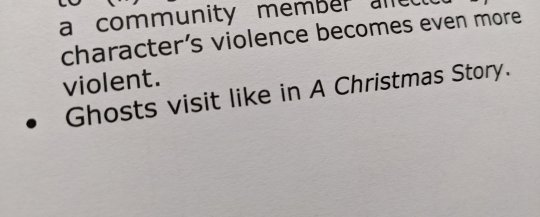
There's a sample adventure in the back (which I'll skip for this read-through) plus loads of random tables. Some wonderfully bizarre stuff in the characters and faction tables. Really gives you a good idea for how gonzo you can go with the setting.
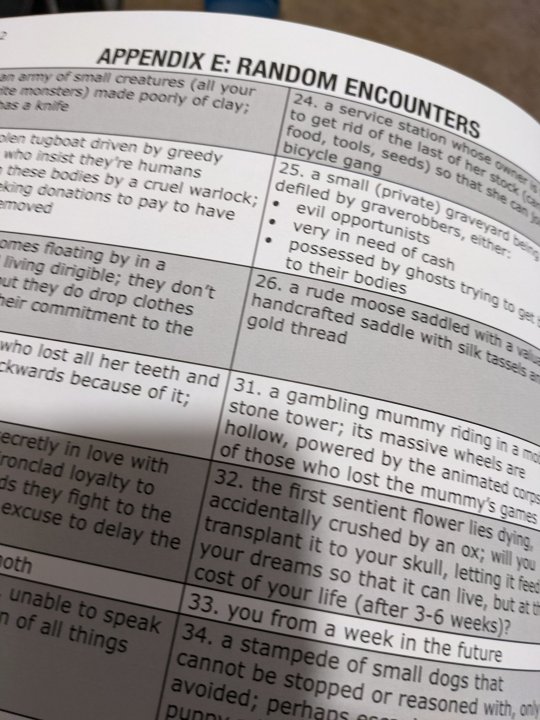
Love these two in particular

Optional rules include hard mode (which I just think is kind of funny to see in PbtA, but could be cool if you lean heavy into the post-apoc setting) and some optional moves. I like that some moves focus on romance, something I enjoy IRL but never think to focus on in games.
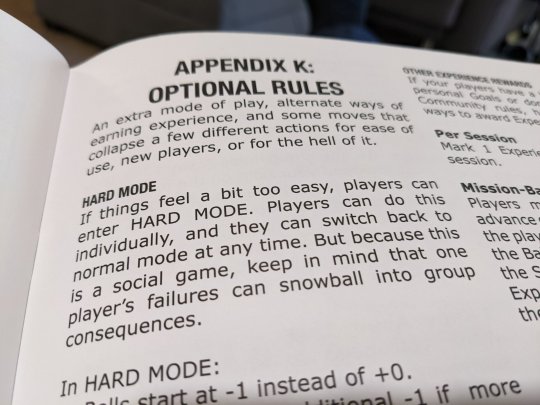
I was wondering why this was the sixth edition!

That's all for the book itself. Going back to the packet to dig into the things I missed. Some expected bits in here but always one or two unique options I really enjoy. Leaking hex is cool (and could have some troubling cascade effects in certain situations).
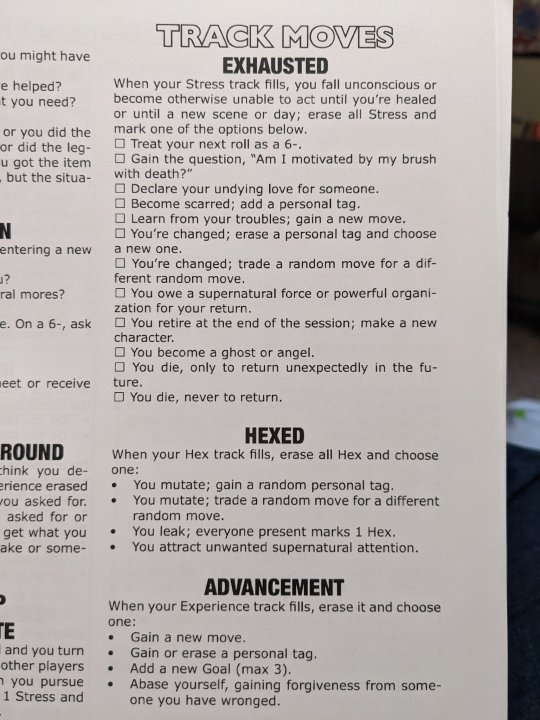
I definitely wish, at least in sitting down to read like this, that the contents of the player packet was also in the book itself. I think PbtA has this tendency of leading to loads of pages on the table, but it can make them very easy to pick up and play or to learn as you play.
That element is definitely here, but I think the vast number of wide-ranging moves and the excitement that would drum up in my player group would more than makeup for that initial overwhelming feel of "whoa, that's a lot of papers out on the table".
Overall, it's the most I've wanted to play a game in this style in a while. I like that the base setup for the world is very much up to the players to determine via the characters they make. I like that PCs here will probably feel unlike any other folks have played before.
The community aspect feels like where I'd want to center my story around, as a player. Seeing that shift and change over time feels like it would be very rewarding and would help lean into the "the old world is dead, what do we want the new world to look like?" theme I enjoy.
Because Aaron King is cool and recently hit a lot of Twitter followers, Patchwork Worlds is now Pay-what-you-want over on Itch.
I'm not sure if physical copies are readily available. For full disclosure (guess I should have said this up front), I got this copy for free from Aaron! Not for the purposes of this thread or anything, just for fun a while back.
Thanks for reading more ramblings from me! If you like to do that sort of thing, check out my newsletter - Missives from the MeatCastle. It's got writings on my work, cool stuff I've run across the web in the last month, and exclusive rpg stuff! https://meatcastle.substack.com
#indie ttrpg#ttrpg#ttrpgs#rpg#fantasy#science fiction#pbta#powered by the apocalypse#aaron king#patchworld world#sixth edition#read through
105 notes
·
View notes
Text
i think it would be too simplistic to say that kinnie shit is the main reason the system zeitgeist is really detached from the literature (especially when some literature IS frequently cited), but i do think that fictional introjects--a documented and completely understandable phenomenon--trying to wed themselves to their sources of inspiration rather than articulating themselves in the real world is a canary in the coalmine for a lot of the other maladaptive patterns we end up seeing.
you could make the case that dissociation is an extreme form of "escape from the self"; to be one person is so intolerable that you escape to another. And then another, and another. so escapism is arguably the driving mode of dissociation.
but if you have these parts of yourself that long to escape BACK to, essentially, a "pre-birth" state, who can't bear to accept the circumstances they're in now, then you're probably more broadly still in an escapist paradigm. and so of course you're gonna be splitting new guys weekly, of course none of you communicate, of course you have these strong and extreme wedges between you and the others and you have these clearly defined boundaries while also, in practice, existing in such a limited context that you haven't really self-actualized.
escapism is an understandable reaction to trauma and severe chronic stress, so rather than dismissing this entire kinnie-system phenomenon as doomed, i think we can build bridges toward an understanding of Living As A System that are more aligned with established and successful therapeutic interventions.
the kinnie-system combo melds two subcultures that magnify maladaptive escapism tenfold. this adds new terminology and points of focus that aren't necessarily relevant or accurate (distinct and discrete identities and roles, "fictive" and "factive" language, source material focus, generally Online behavior and interests), and obscures other experiences (lack of clear identity, blending and blurring, dissociation as a coping mechanism for the stresses of tangible daily life, introjection as a start¬ an end) and strategies (expanding the window of tolerance, grounding in the present, unburdening of extreme roles, intra-system cooperation, etc.)
i think as you work toward a grounded view of yourself and accept your reality, you can start to hold yourself more proudly, and own your experiences--even the bizarre one of essentially being a cartoon character ejected from the screen to do dishes.
dissociation is mushy, highly individual, and weird, but also a really practical solution to an impossibly difficult problem. i'd like it if we could change the common vocabulary and perspective to better reflect the diverse and unique experiences of finding a way to live When Guys.
79 notes
·
View notes
Note
Why are you done with the discourse of the unhealthy coping mechanism? (neutral tone of genuine curiosity)
bleh i might effortpost about this at some point but i already have issues with the idea of the 'coping mechanism' as a distinct category of behaviour—like, what under an inherently violent social system is not a 'coping mechanism' lmao. when people tacked on the 'unhealthy' qualifier my sense is this was an effort to move away from certain more overtly stigmatising discourses whereby behaviours are designated 'normal' or 'abnormal' and correspondingly 'good' / 'allowed' versus 'bad' / 'forbidden'. the idea of an 'unhealthy coping mechanism' was, i think, initially meant to capture the idea that a behaviour doesn't have to be inherently 'good' or socially acceptable in order to be named, commiserated over, or treated. which is not an ignoble motive. but because this logic fails to question or challenge in any way the psychiatric establishment, the logic of the 'cure', or the social conditions giving rise to affective distress, what it actually results in is a set of really rancid discourses positioning the 'unhealthy coping mechanism' as a kind of stopgap that must be intervened upon (forcibly if necessary) and replaced with better, 'healthy' behaviours that are more acceptable to various powers (the family, the employer, etc) interested in enforcing the subject's compliance and obedience for ease of participation in existing social systems. i hate it and i hate that stigmatised (and, yes, self-destructive!) behaviours often live in this specific contested zone where we're only supposed to talk about them if we subsume them into the 'unhealthy coping mechanism' framework—something to overcome, something we're 'seeking help for' and know is 'bad' and aren't supposed to find funny or meaningful or, idk, valuable in any way, because this would be 'glorifying' something 'unhealthy' (notice the moral work that designations of health do here lmao). i think the phrase and the entire framework are, by design, limiting of psychiatrised people's abilities to talk about ourselves and to narrativise our own thoughts and behaviours. it's a command to submit—to make ourselves socially and medically legible in a way the institutions are comfortable with. For Your Own Good :)
136 notes
·
View notes
Note
Hey. Why do you think Karen Page is a character people seem to hate so much? I’m fairly new to the fandom and I’ve seen people even badmouthing the actress as well, which is awful. I am curious to know what you think about it.
Welcome to the fandom! 💖 I'm so excited for you and I'm super happy that, despite being newish, you're interacting like this. (It took me an embarrassing amount of time to be brave enough to send asks to people lol.)
Also, this is such an interesting question.
I want to address the attacks against Deborah Ann Woll first. No matter how anyone feels about a character, it's absolutely despicable to attack the actor over it. Most of the attacks I've seen have been about her looks, or about her acting abilities. It's fine to critique acting abilities, but looks should be off the table. But even the critiques of her acting abilities aren't actually critiques - they're just, like you said, badmouthing, with little to no analysis. To me, that indicates that they're hating on the actress just because they're emotional (angry or annoyed) over the character.
So why do people get so emotional over Karen?
I think the easiest explanation is: ship wars. Some people struggle to enjoy their favorite ship without tearing down competitor ships. And since Karedevil is one of the few ships that was actually canon (albeit temporarily, but S3 ended with them being pretty flirty again), Karen becomes a huge target.
Another explanation is that Karen appears to be written inconsistently. Personally, I don't think she actually is (except perhaps in The Punisher; I'm not sure because I've only seen S1 of The Punisher). The argument goes: "She loves Daredevil until she finds out Daredevil is Matt, and then she treats it like an addiction, despite being supportive of Frank."
The counter-argument, to me, is clear: she still loves Daredevil, but she hates being lied to and put on a pedestal. Matt did both of those things. Frank (for the most part) did neither of those things. Her issue is with Matt, not Daredevil (which she makes explicitly clear in S3E1, but people still apparently confused on this point). With that in mind, I think she's written consistently in an incredibly nuanced way.
Another explanation is that Karen is a character who doesn't learn from her mistakes. She's rash and reckless and she lies just as much as Matt, and more often than not, people end up dead because of it. Ben is the most obvious and chilling example. Yet even after her actions get Ben killed, and she expresses serious guilt and remorse, she continues to do the same thing. That makes people wonder: is she stupid? Or, worse: was her guilt and remorse only an expression of her personal grief, and not actually the result of evaluating her actions affected Ben?
This, to me, is the most fair critique of Karen, and I sympathize with people who dislike her because of it. I will point out, however, that Matt and Foggy also repeat the same mistakes. It's obvious with Matt; it's talked about less often with Foggy, but I roll my eyes every time he acts like Matt and Karen are being reckless for wanting to operate outside the law - despite the fact that every time they limit their plans to operating inside the law, people end up dead. This makes me wonder: is Foggy stupid? Or does he simply care more about keeping Matt and Karen alive (and out of jail) than he cares about other people dying?
The actual explanation, I think, is that Daredevil is a show about very flawed and surprisingly realistic characters. People rarely shake off old habits and bad ways of thinking quickly. No matter how many times you tell a person that their friends are there for them, they (like Matt) may continue to push people away if that's their coping mechanism. No matter how many times you tell a person to ask for help before doing something alone, they (like Karen) may continue to go rogue if that gives them some feeling of control over their lives. No matter how many times you tell a person that the systems they want to trust are broken, they (like Foggy) may continue insisting that everyone should trust the system if they continue seeing the world through a lens of privilege.
Can it be frustrating to watch? Absolutely. Is it a good reason to hate a character? I'd say no, but I guess that's more subjective. Is it a reminder to all of us to be gentle and patient both with ourselves and with other people when we find ourselves making the same mistakes over and over? I hope so!
I've said before that I sometimes feel self-conscious over the fact that, in my longer stories, a character's growth is rarely linear. It's usually what I think of as a spiral. They make a mistake, they learn from it...and then the stakes rise, and so they fall back on that old mistake again, since it's comfortable and familiar, rather than trying a new approach. Or the character tries to blend the old mistake with the new approach, to varying degrees of success. Sometimes I worry that this feels repetitive, or like the character isn't learning.
But from the comments I've received, people seem to appreciate it more often than not. They resonate with it and relate to it.
So now that I think of it...maybe the root problem is simply that Daredevil doesn't have author's notes telling us why Karen (and Foggy and Matt) are making the same mistake again. 😅
Or maybe people are more compassionate towards characters in fanfiction than on TV? Or maybe people are more compassionate towards the main character than the side character? Or maybe it's misogyny? Or maybe people are just less compassionate towards Karen in particular because she threatens their favorite ship.
Aaaaand this post has come full circle.
176 notes
·
View notes
Note
re: talk of Burn, do you have any idea why Yang's aura clearly broke when Neo struck her in V8 (right after activating Burn)? my theory is that perhaps activating her semblance does something like Tock's where it makes her aura manifest more solidly on her body (which is how it can make her hair light on fire) and therefore also, like Tock, means that her aura is more vulnerable. to me this would also explain why Yang would use it as a finisher at first; using it when she's already going to run out of aura makes it, in a sense, less dangerous because she's already gotten most of the other uses out of her aura that she can get.
would love to know if you think this is accurate, or what you actually think is going on with yang's semblance on a mechanical level (if you're interested in that anyway)
first, a general point about aura and aura breaking. the characters’ use of meters has led to a sort of popular fanon that aura works like hit points in a video game, where you have this many and taking damage reduces your HP by a certain number until you hit zero and then your aura breaks; (dark souls splash screen voice) YOU DIED.
i do not think it works that way.
from world of remnant:
aura is a manifestation of the soul, a life force that runs through every living creature on remnant—whether they are a meager shopkeep or a renowned knight. however, what sets true warriors apart from all others is their ability to amplify and control their aura.
aura is the power of one’s soul. it’s guided by emotion, self-knowledge, and spirituality. in its purest form, it becomes a semblance.
defensive aura is not a passive effect. we know this for a fact. in V5, oscar finds it physically exhausting to engage his aura in this way and ren tells him that’s normal—it requires intense concentration at first, then becomes second nature with practice. in V7, jaune’s aura-training demonstrates that recovery, regaining aura once it has been depleted, is a conscious action that can be improved through practice. this is because the “aura level” tracked by those meters is not a measurement of how much aura you have in the tank, as it were, but something like the density of the aura-field you’re pushing outward, or speed of flow, or something along those lines.
(the way i’m handling it in TDT is there’s a hard upper bound to how much aura you can hold in your skin, like a sponge not being able to absorb more water, and what auraleric gauges attempt to measure is % of maximum saturation because everyone’s aura will break around 5-10% saturation even though the amount of aura you have at 100% varies. anything you push out above that threshold is projected as transient bursts of energy and that’s where you start getting into offensive techniques.)
hazel’s phenomenal endurance is noted to derive from his rapid recovery, not the basal amount of aura he has. (he even just shrugs off being impaled.) i believe his semblance gives him an edge here, because it requires concentration to amplify one’s aura and hazel can’t be distracted by physical pain.
which brings me to aura-breaking. it doesn’t happen when the proverbial tank is empty. auras break when you can’t sustain the mental effort of generating enough aura; this might happen because the well you’re drawing from really has run dry (<- think this is what happened to nora with the high voltage door), but it might also be because you’re too tired, or you took a really painful or unexpected hit that shattered your focus, because you’re panicking or furious.
i think tock’s semblance is in the same ‘family’ as hazel’s and ironwood’s in that it puts her into a state of intense focus by blocking out anything that might shake her—with hers being far, far more potent than theirs but so potent she can’t maintain it for longer than sixty seconds, and possibly needs the ticking clock to ‘anchor’ her focus.
(fic stuff again, because tock’s alive in TDT for butterfly wing flaps reasons: sixty seconds is not a hard limit of her semblance; she can and on one occasion did go for much longer. to project an aura field you draw aura out of your reserve, which is the aura that naturally ‘pools’ around your soul; if that runs dry and you’re desperate enough, pushing hard enough, you can wring more aura out of your soul. blood from a stone. it hurts a lot, it will mess you up, and it can do permanent damage similar to what the aura transfer machines do to pietro. sixty seconds is how long it takes for tock’s semblance to drain her aura reserve, rounded down to allow for a margin of error.)
so. yang.
i think, mechanically, when the average person with aura training gets hit, their aura burns up to disperse most of that energy. (<- when they’re swatting gunfire away, the bullets bounce; the energy is reflected.)
but yang’s semblance absorbs energy—which is to say, if you had a ball throwing machine shoot a tennis ball at yang and someone else with equivalent training from the same distance, it would hit yang harder because her aura is less reflective; more of the ball’s kinetic energy flows into her body. then, like a battery, her aura converts that energy into some other form that can be stored.
sort of like dust, in fact. dust has a lot of potential energy, which is released when the material reacts with aura. given the literally explosive firepower yang gains from burn, i think that she’s storing this absorbed energy in the same form as occurs naturally in dust, which would put burn in the same ‘family’ as coco’s hype or arrastra’s equilibrium…
…and would also mean that this statement:
some prefer to use dust in its raw form: elegant, yet destructive. those who choose to wield dust in this state must possess a certain level of discipline to ensure that their resulting powers do not break free of their control.
is true of burn, too. and that tracks with who yang is and how she uses her semblance—even in V1-3, yang takes a more head-on approach to fights and tends to soak up more damage before exploding bigger vs her increasingly nimble and even acrobatic style post-beacon, but her control over those massive volcanic eruptions is immaculate.
the way burn works in general requires that yang be very, very in control of her aura at all times because she needs to balance between absorbing energy to charge up her semblance while reflecting enough to prevent injury, and this is one reason why i think yang is probably the best out of the cast when it comes to using aura. ren might have her beat on the more spiritual, extra-sensory perception side of things, but yang has to keep her focus while getting hit harder than anyone else Because Physics.
and that brings us to neo one-shotting yang’s aura. here is what happens: cinder is gloating from atop a pillar of fire while people scream and run in a panic all around them, and out of the corner of her eye, yang sees a glint of steel and realizes that neo is about to stab her unsuspecting baby sister in the back, she’s too far away, she can’t get there fast enough—burn is, in that moment, a reflex. instinct. she panics and hurls herself in between neo and ruby without even thinking about it because the only thing in her mind is GET TO RUBY NOW.
and that’s why her aura just shatters. it requires concentration—you practice until it becomes instinctive, until you don’t need to think about it, muscle memory. but it still takes focus. intention. yang has incredible self-control and thus incredible control of her aura, but everyone has limits, and hers are “holy fuck that guy stabbed blake” and “neo is going to kill ruby go go go.”
her semblance in itself doesn’t make her defense any weaker—but when she’s terrified enough for burn to activate reflexively like this, her aura will break if she gets hit because she’s freaking out.
46 notes
·
View notes
Note
Ahhh, sorry minor thing (has to do with your body swap comic) just thinking about the Mikey sensory overload bit. I saw this thread on it talking about his sensory issues and it hasn't left my mind since. It basically was a bunch of clips showcasing those issues in the show so seeing it in a comic is such a woah moment. Basically I was just curious on your thoughts on it.
yooo there's a whole thread about it? i haven't seen that but now i really want to omg if anybody has the link or something lmk
ok anyways rant under the cut lets go
I have a Few Thoughts about the bros and their neurodivergencies, both the ones headcanoned by fans and the ones actually confirmed

And these are the two main confirmed ones from the writer/producer of the show! Donnie's was a given just by observing how he's characterized in the show, and Mikey's became obvious once you recognize how hyper and impulsive he can be sometimes.
That one scene in Donnie's Gifts perfectly encapsulates how his brain works for me, where he forgot to mention a famous chef turned into a pig mutant live on television because he wanted to make sure the food he was making at the time turned out right and literally just forgot about the whole ordeal right after lmao
I'll be honest, a lot of the characteristics of ADHD he exhibits for me are mostly personal headcanons since I never took much notice of how his actions in the show can be recontextualized with the knowledge he's neurodivergent, but the one thing I DID notice is how often he goes into his shell.
Obviously it's a box turtle thing, his species is more inclined to hide in their shell since the carapace can actually close fully, making it a viable survival tactic. And with ADHD, I imagine any kind of unpleasant sensation or a sensory overload would trigger this escape mechanism, since being in his shell is equated with safety and control for him. It keeps the Bad Vibes out and lets him recenter himself
As for what would cause a sensory overload for him I have no clue, maybe it wouldn't be anything specific and I don't want to just project my own sensory issues onto him so I shall leave that open ended for now.
Though I do imagine food would be a big thing for him. It seems like one of his bigger special interests, so I'd find it to be an interesting dilemma for him to have a limited palate despite his interest in cooking. He would definitely make it a personal mission to experiment and try as many things as possible just for the chance to find new stuff he finds enjoyable, but in the process end up finding out a bunch of other foods are practically inedible for him.
If anyone has other thoughts on this feel free to add them, I love these kinds of discussions on character analyses and trying to see how their neurodivergencies are portrayed within the context of the show :]
#i also headcanon leo as being adhd just in a different font#and raph as innatentive adhd with just a touch of autism#they all just give me that vibe idk why#rottmnt#rottmnt rant#rottmnt mikey#asks open
154 notes
·
View notes
Text
also genuinely thinking about becoming a math major down the road. college math is so much more fun and interesting and practical than it ever felt in 1-12 grade. i find myself thinking about limits and tangents and integrals a lot lately and its like. very cool to see it in real world applications.
like in high school it was just "you'll use this someday" which, imo, is a bad way of explaining the situation; in high school you can't account for which students will be mechanics, scientists, developers, etc or which ones will live out their lives in retail, or fast food service, ow whatever. neither thing is worse than the other, but the point is you don't know who will use trig in daily lives so you teach everyone. i don't remember a thing about chemistry and never suffered for it but i have a friend who is a nuclear engineer (insane) and its like the basis for his life.
all that aside, i went from "math is whatever" to "im genuinely thinking about this half of my day and using it in the most nonsensical and probably incorrect ways, but its so fun to do" and i enjoy it
101 notes
·
View notes